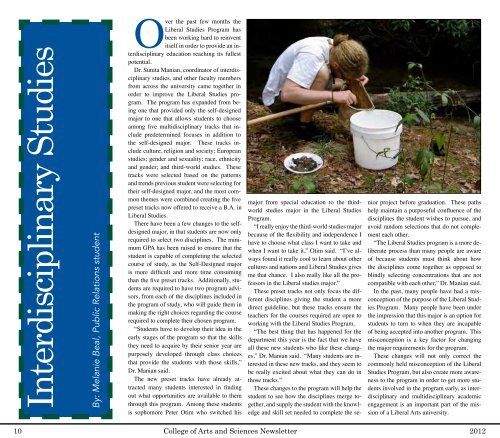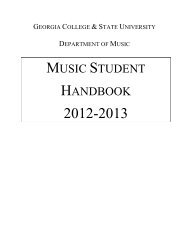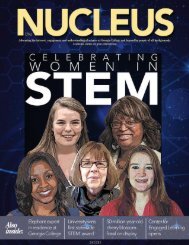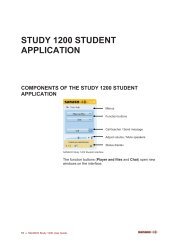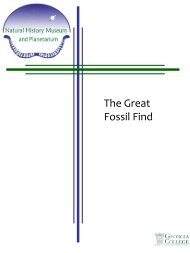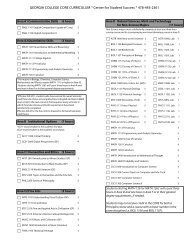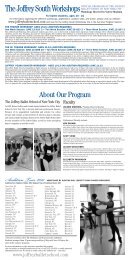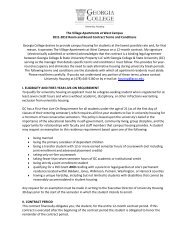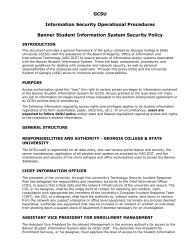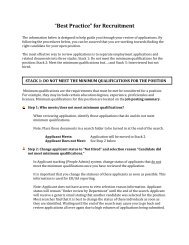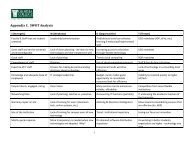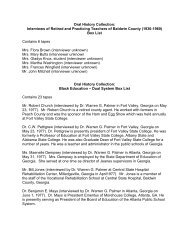College of Arts and Sciences Newsletter - Georgia College & State ...
College of Arts and Sciences Newsletter - Georgia College & State ...
College of Arts and Sciences Newsletter - Georgia College & State ...
You also want an ePaper? Increase the reach of your titles
YUMPU automatically turns print PDFs into web optimized ePapers that Google loves.
Interdisciplinary Studies<br />
By: Melanie Beal, Public Relations student<br />
Over the past few months the<br />
Liberal Studies Program has<br />
been working hard to reinvent<br />
itself in order to provide an interdisciplinary<br />
education reaching its fullest<br />
potential.<br />
Dr. Sunita Manian, coordinator <strong>of</strong> interdisciplinary<br />
studies, <strong>and</strong> other faculty members<br />
from across the university came together in<br />
order to improve the Liberal Studies program.<br />
The program has exp<strong>and</strong>ed from being<br />
one that provided only the self-designed<br />
major to one that allows students to choose<br />
among five multidisciplinary tracks that include<br />
predetermined focuses in addition to<br />
the self-designed major. These tracks include<br />
culture, religion <strong>and</strong> society; European<br />
studies; gender <strong>and</strong> sexuality; race, ethnicity<br />
<strong>and</strong> gender; <strong>and</strong> third-world studies. These<br />
tracks were selected based on the patterns<br />
<strong>and</strong> trends previous student were selecting for<br />
their self-designed major, <strong>and</strong> the most common<br />
themes were combined creating the five<br />
preset tracks now <strong>of</strong>fered to receive a B.A. in<br />
Liberal Studies.<br />
There have been a few changes to the selfdesigned<br />
major, in that students are now only<br />
required to select two disciplines. The minimum<br />
GPA has been raised to ensure that the<br />
student is capable <strong>of</strong> completing the selected<br />
course <strong>of</strong> study, as the Self-Designed major<br />
is more difficult <strong>and</strong> more time consuming<br />
than the five preset tracks. Additionally, students<br />
are required to have two program advisors,<br />
from each <strong>of</strong> the disciplines included in<br />
the program <strong>of</strong> study, who will guide them in<br />
making the right choices regarding the course<br />
required to complete their chosen program.<br />
“Students have to develop their idea in the<br />
early stages <strong>of</strong> the program so that the skills<br />
they need to acquire by their senior year are<br />
purposely developed through class choices<br />
that provide the students with those skills,”<br />
Dr. Manian said.<br />
The new preset tracks have already attracted<br />
many students interested in finding<br />
out what opportunities are available to them<br />
through this program. Among these students<br />
is sophomore Peter Otim who switched his<br />
major from special education to the thirdworld<br />
studies major in the Liberal Studies<br />
Program.<br />
“I really enjoy the third-world studies major<br />
because <strong>of</strong> the flexibility <strong>and</strong> independence I<br />
have to choose what class I want to take <strong>and</strong><br />
when I want to take it,” Otim said. “I’ve always<br />
found it really cool to learn about other<br />
cultures <strong>and</strong> nations <strong>and</strong> Liberal Studies gives<br />
me that chance. I also really like all the pr<strong>of</strong>essors<br />
in the Liberal studies major.”<br />
These preset tracks not only focus the different<br />
disciplines giving the student a more<br />
direct guideline, but these tracks ensure the<br />
teachers for the courses required are open to<br />
working with the Liberal Studies Program.<br />
“The best thing that has happened for the<br />
department this year is the fact that we have<br />
all these new students who like these changes,”<br />
Dr. Manian said. “Many students are interested<br />
in these new tracks, <strong>and</strong> they seem to<br />
be really excited about what they can do in<br />
those tracks.”<br />
These changes to the program will help the<br />
student to see how the disciplines merge together,<br />
<strong>and</strong> supply the student with the knowledge<br />
<strong>and</strong> skill set needed to complete the senior<br />
project before graduation. These paths<br />
help maintain a purposeful confluence <strong>of</strong> the<br />
disciplines the student wishes to pursue, <strong>and</strong><br />
avoid r<strong>and</strong>om selections that do not complement<br />
each other.<br />
“The Liberal Studies program is a more deliberate<br />
process than many people are aware<br />
<strong>of</strong> because students must think about how<br />
the disciplines come together as opposed to<br />
blindly selecting concentrations that are not<br />
compatible with each other,” Dr. Manian said.<br />
In the past, many people have had a misconception<br />
<strong>of</strong> the purpose <strong>of</strong> the Liberal Studies<br />
Program. Many people have been under<br />
the impression that this major is an option for<br />
students to turn to when they are incapable<br />
<strong>of</strong> being accepted into another program. This<br />
misconception is a key factor for changing<br />
the major requirements for the program.<br />
These changes will not only correct the<br />
commonly held misconception <strong>of</strong> the Liberal<br />
Studies Program, but also create more awareness<br />
to the program in order to get more students<br />
involved in the program early, as interdisciplinary<br />
<strong>and</strong> multidisciplinary academic<br />
engagement is an important part <strong>of</strong> the mission<br />
<strong>of</strong> a Liberal <strong>Arts</strong> university.<br />
Providing h<strong>and</strong>s-on education<br />
continues to be a focus <strong>of</strong> the<br />
Mass Communication Department<br />
<strong>of</strong> <strong>Georgia</strong> <strong>College</strong>. Pr<strong>of</strong>essors<br />
place great emphasis on this in their<br />
individual syllabi <strong>and</strong> in the curriculum as a<br />
whole. The most recent addition to this focus<br />
was the construction <strong>of</strong> a media lab in the <strong>Arts</strong><br />
& <strong>Sciences</strong> building. Room 1-64 has been<br />
transformed into a multimedia l<strong>and</strong>scape for<br />
students to explore their own potential.<br />
Dr. Mary Jean L<strong>and</strong>, chair <strong>of</strong> the Department<br />
<strong>of</strong> Mass Communication, is thrilled that<br />
students have an innovative space to access<br />
the latest print, audio, video <strong>and</strong> web resources.<br />
“The converged design <strong>of</strong> the lab allows<br />
students to seek creative solutions to complex<br />
communication scenarios utilizing the latest<br />
technology,” Dr. L<strong>and</strong> said.<br />
Included in the lab are 20 seats with 20<br />
Mac Pro computers, a teacher’s station, a<br />
Mac mini <strong>and</strong> a SMART Board. Each computer<br />
also includes the entire Adobe Creative<br />
Suite. Possibly the most unique attribute <strong>of</strong><br />
the lab is the layout. While most computer<br />
labs are not conducive to teaching practices,<br />
this room was specifically designed to accommodate<br />
the student-teacher experience.<br />
The teacher’s station is located in the center<br />
<strong>of</strong> the room surrounded by the students <strong>and</strong><br />
their workspaces. The purpose <strong>of</strong> the room is<br />
to teach students the theories <strong>and</strong> foundations<br />
<strong>of</strong> communication while allowing them to apply<br />
what they learn instantly.<br />
Dr. Kristin English, assistant pr<strong>of</strong>essor <strong>of</strong><br />
Mass Communication, taught Public Relations<br />
Administration in the lab <strong>and</strong> utilized<br />
the resources to teach her Theory <strong>and</strong> Research<br />
classes how to use a statistical analysis<br />
s<strong>of</strong>tware called SPSS. She has found the<br />
layout <strong>of</strong> the room to be extremely efficient<br />
<strong>and</strong> looks forward to integrating lab work into<br />
future classes.<br />
“I think it will definitely lend a great resource<br />
to all Mass Communication students,”<br />
Dr. English said. “This field is about utilizing<br />
the tools that we have.”<br />
Classes such as seminar, video <strong>and</strong> research<br />
were held in the space during the fall 2011<br />
semester. In spring 2012, the classes scheduled<br />
will be the ones that utilize the s<strong>of</strong>tware<br />
provided. The lab is an on-going project, in<br />
addition to the video lab on the third floor, <strong>of</strong><br />
<strong>Arts</strong> & <strong>Sciences</strong>, this lab is meant to enhance<br />
the learning experience by providing access<br />
to programs that students will find useful for<br />
internships <strong>and</strong> jobs.<br />
“To be competitive, our students need to<br />
work with industry st<strong>and</strong>ard s<strong>of</strong>tware,” Dean<br />
<strong>of</strong> the <strong>College</strong> <strong>of</strong> <strong>Arts</strong> & <strong>Sciences</strong> Ken Procter<br />
said. “Mass Communication is a big program<br />
with lots <strong>of</strong> students, so having a dedicated<br />
media lab makes sense.”<br />
The lab also provided the opportunity to<br />
create a server specifically for the Mass Communication<br />
program. Dr. Stephen Price, assistant<br />
pr<strong>of</strong>essor <strong>of</strong> Mass Communication, created<br />
a log-in for all <strong>of</strong> the students so that they<br />
can access their work on other computers on<br />
campus. This also means that Dr. Price can<br />
assist students working on the server through<br />
his <strong>of</strong>fice computer.<br />
“The benefit for them is that they don’t<br />
have to coordinate an appointment or wait<br />
until I get a chance to go to the labs from my<br />
<strong>of</strong>fice to get help,” Dr. Price said. “It allows<br />
me to see their screens with any error messages<br />
<strong>and</strong> guide them through the steps they<br />
need to do to troubleshoot when they run into<br />
problems.”<br />
The federal government recently gave<br />
monies to colleges <strong>and</strong> universities around<br />
the country to assist with the impact <strong>of</strong> budget<br />
cuts. These stimulus funds were only available<br />
for two years. “(Former) President Lel<strong>and</strong><br />
set aside some <strong>of</strong> the funds for ‘move the<br />
needle’ projects—that is projects that would<br />
make a significant positive impact on <strong>Georgia</strong><br />
<strong>College</strong>,” Dean Procter said. The media lab<br />
project was one <strong>of</strong> many projects proposed<br />
by the colleges on campus. Due to the cost, it<br />
probably wouldn’t have been possible without<br />
the help <strong>of</strong> the “move the needle” funds.<br />
“I feel that this new facility has made the<br />
students more enthusiastic about learning. It<br />
shows that the department <strong>and</strong> college takes<br />
the program seriously by providing a top <strong>of</strong><br />
the line room tailored for us,” senior mass<br />
communication student Bailey Tuck said.<br />
“The investment in the new lab is ultimately<br />
an investment in us.”<br />
By: Stephanie Reagan, Public Relations student<br />
Communication<br />
Department <strong>of</strong> Mass<br />
10 <strong>College</strong> <strong>of</strong> <strong>Arts</strong> <strong>and</strong> <strong>Sciences</strong> <strong>Newsletter</strong> 2012 2012 <strong>College</strong> <strong>of</strong> <strong>Arts</strong> <strong>and</strong> <strong>Sciences</strong> <strong>Newsletter</strong> 11


